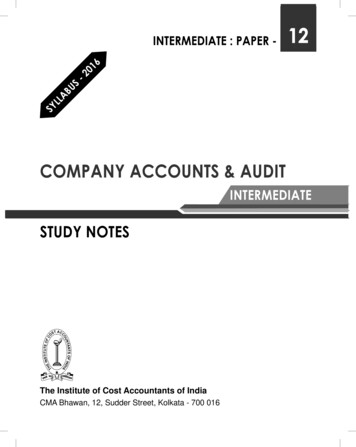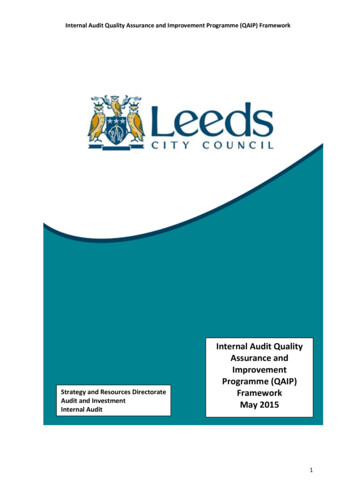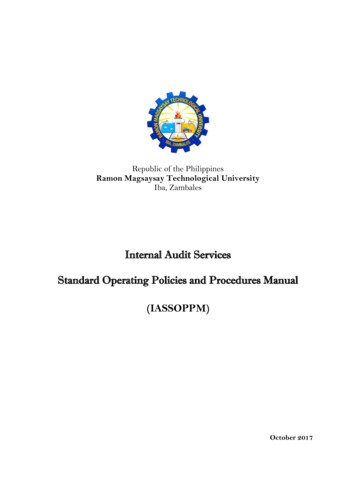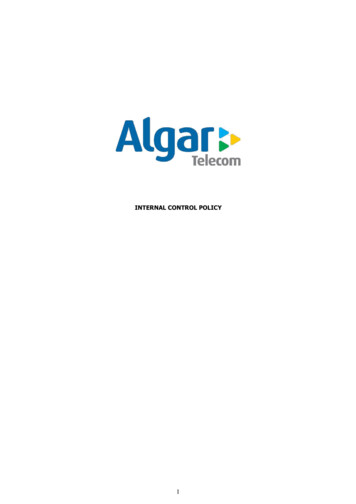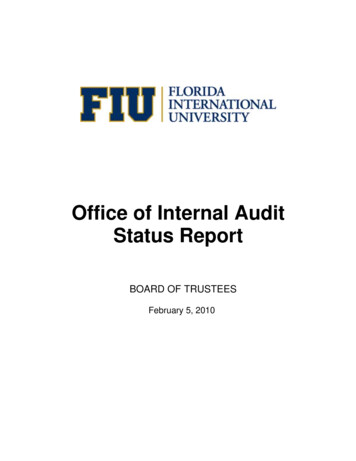
Transcription
Office of Internal AuditStatus ReportBOARD OF TRUSTEESFebruary 5, 2010
Office of Internal AuditDate:January 13, 2010To:Board of Trustees and Finance and Audit CommitteeFrom:Allen Vann, Audit DirectorSubject:OFFICE OF INTERNAL AUDIT STATUS REPORTCOMPLETED AUDITS AND INVESTIGATIONSSince our last Finance and Audit Committee meeting on November 19, 2009 we completed thefollowing projects:1.University Asset Management Accounting Observations – Based on recent audits andinvestigations and additional observations, we highlighted in this review a number of issuesrelating to University personal property accounting that requires the attention of the Controller’sOffice. We reported the need to further strengthen surplus media procedures so as to ensure thatsensitive data are properly removed to avoid a data breach. Also, before donating surplusproperty to nonprofit organizations better communication to the University community mightidentify internal needs and when donating property staff needs to ensure that organizationslegitimately qualify as nonprofits.There also needs to be greater accountability over attractive property items that fall under the 1,000 property recording threshold. Our inventory records also have to more accurately reflectpersonal property locations. Management has implemented or is in the process of implementingthe ten recommendations resulting from this review.2.Investigation of Improper Procurement Card Use and Questionable Payroll Transactionsin the College of Education – This report summarized the results of three investigations relatingto Procurement card use in the College of Education. Based on a complaint we initiated aninvestigation to determine whether the University was defrauded as a result of the questionableprocurement activity. Based on our investigation, we concluded that an Administrative Assistantmisused the procurement card provided to her by the University by purchasing personal andunallowable items. The Administrative Assistant also made procurement card transactions at thedirection of the former Interim Dean to reward certain employees.The current Interim Dean of the College of Education Business in consultation with the Provost,Human Resources, and Office of the General Counsel took appropriate disciplinary actionresulting in the separation from employment of the Administrative Assistant and the OfficeAssistant responsible for approving her credit card transactions. The Office of Internal Auditsalso referred this matter to FIU Police. An active criminal case is pending in the State Attorney’sOffice.
Office of Internal Audit Status ReportJanuary 13, 2010Page 2 of 33. Investigation of Improper Procurement Card Use at the College of Education – FormerInterim Dean – This report represents the second of three investigations of procurement card useat the College of Education. This investigation focuses on the former Interim Dean of theCollege, who subsequently returned to his responsibilities as a Professor at the College. Basedon our investigation, we concluded that the former Interim Dean misused the procurement cardprovided to him by the University by purchasing personal and unallowable items. In addition, theformer Interim Dean instructed the Information Technology Director and the formerAdministrative Assistant to purchase numerous personal and unallowable items for him andothers using their procurement cards. We also noted other instances of inappropriate and wastefulspending made at the former Interim Dean’s direction. These expenditures included payment ofindiscriminate bonuses, payroll/timekeeping manipulation for an OPS employee, and wastefultravel costs.The current Interim Dean of the College of Education in consultation with the Provost, HumanResources, and Office of the General Counsel is in the process of taking appropriate disciplinaryaction resulting in the separation from employment of the Professor and monetary restitution.4.Investigation into Allegations Against a Professor at the College of Medicine – Thisinvestigation was based on a complaint forwarded to us through the Division of HumanResources alleging that a Professor at the College of Medicine had misused grant funds. Otherallegations were investigated by the Division of Human Resources, the Office of SponsoredResearch Administration (OSRA) and the College of Medicine (College).Based on our investigation, we concluded that the Professor had several business relationshipsoutside the University that he should have reported. In addition, there were purchases ofcomputers which should not have been made using the University procurement card. Finally, ourreview disclosed a weakness in the manner in which the College accounted for FedExtransactions to ensure that shipments were business related. Otherwise the allegations were notsustained, i.e., there was insufficient evidence to prove or disprove the allegation(s).We made six recommendations that the College of Medicine agreed to implement.
Office of Internal Audit Status ReportJanuary 13, 2010Page 3 of 3WORK IN PROGRESSAudits/InvestigationsInvestigation of ProCard use at the College of EducationInvestigation of ProCard use at the College of MedicineAudit of the University Purchasing Card ProgramAudit of the University’s IT GovernanceAudit of Financial Controls Over College of Medicine ExpendituresAudit of the University’s Information System Continuity PlanAudit of the Federal Stimulus FundsReview of PeopleSoft Upgrade ImplementationStatusFieldwork in progressFieldwork in progressFieldwork on holdFieldwork in progressFieldwork on holdFieldwork in progressFieldwork in progressFieldwork in progressCONSULTING ACTIVITIESIn conjunction with our Interim Controller, I have designed and am providing training to University staffon Understanding Fraud in University Credit Card Programs. This course provides fraud awarenesstraining to staff and an overview of related policies and required procedures.RESULTS OF QUALITY ASSESSMENTOF THE OFFICE OF INTERNAL AUDITSAt our last Finance and Audit Committee meeting, I provided a detailed report of a Quality SelfAssessment I performed of the Office of Internal Audit. Attached is an independent validation of ourassessment. I am pleased to inform you that the independent validator concluded that FIU’s internalaudit department conforms to the International Standards for the Professional Practice of InternalAuditing,FOLLOW-UP STATUS REPORTSDue to time constraints and the short lead time between meetings we will update the Finance and AuditCommittee on the implementation status of audit recommendations at our next scheduled meeting.Attachment
INDEPENDENT VALIDATIONQUALITY ASSESSMENT OFFLORIDA INTERNATIONAL UNIVERSITYOFFICE OF INTERNAL AUDITDrummond Kahn, MS, CIA, CGFM, CGAP
TABLE OF CONTENTSTransmittal Letter1Table of Contents2Independent Validator Statement3Objective, Scope, and Methodology4Observed Strengths6Potential Challenges9Opportunities for Improvement and Recommended Action Items102
OBJECTIVE, SCOPE AND METHODOLOGYIn November, 2009, I was engaged to conduct an independent validation of FloridaInternational University’s self-assessment (Quality Assessment) of its internal auditfunction.The primary objective of the validation was to verify the assertions made in the attachedquality self-assessment report concerning adequate fulfillment of the organization’s basicexpectations of the internal audit activity and its conformity to The Institute of InternalAuditors’ (The IIA’s) International Standards for the Professional Practice of InternalAuditing (Standards). Other matters that might have been covered in a full independentassessment, such as an in-depth analysis of successful practices, governance, consultingservices, and use of advanced technology, were excluded from the scope of thisindependent validation by agreement with the Audit Director.The internal audit self-assessment, and my independent validation, used the QualityAssessment Manual for the Internal Audit Activity (6th Edition) by the Institute ofInternal Auditors’ Research Foundation (2009).The University’s internal audit function prepared an extensive self-assessment report, andprovided this report and its supporting documentation to me in November. I reviewedthis information and conducted a site visit in December. During the site visit, I met witheach internal auditor on the staff, and conducted interviews of each auditor, the Chief ofStaff to the President, the Chief Financial Officer, the Chief Information Officer, and theFinance and Audit Committee Chair, using IIA guidance for interview topics andquestions, as well as follow-up questions as I deemed appropriate.I had full access to internal audit documentation during my visit in December. I reviewedworkpapers from two audit engagements I selected, as well as many recently-issued auditreports. I observed operating procedures in the office, discussed my questions from theself-assessment with audit staff and the Audit Director, and reviewed resumes and theprofessional and academic background of each auditor on the staff. In addition, Ireviewed the format for and two recent examples of the office’s “Audit ReviewChecklist”, which appeared complete and appropriate and consistent with professionalpractices to document assignment reviews.I also reviewed survey responses from two surveys administered before and during thesite visit – a survey of auditees and university management, and a second survey of auditstaff members.During my site visit, I had the full cooperation of all staff members and with theindividuals outside the audit function I interviewed. All offered frank and directfeedback on the audit activity, and fully participated in the validation process.4
I reviewed office processes and manuals/guidance, including the 2006 operations manual(now under revision). I reviewed the audit function’s authority, process, charter; theBoard structure for management and the audit committee; the office’s status reportingprocess to the audit committee and executive management; the followup process andprocess for describing followup to management and the audit committee; and positiondescriptions for audit staff.After my site visit, I reviewed the self-assessment documentation again, as well as thenotes from my interviews and the IIA Quality Assessment Manual, prior to preparing thisfinal summary document. My notes and this document will be stored with the selfassessment working papers at Florida International University.I conducted my work from November 2009 to January 2010 based on my knowledge andexperience in auditing (since 1990) and my experience leading and participating inexternal quality reviews of several audit offices, as well as with the guidance from theIIA Quality Assessment Manual described above.I prepared the final documentation for this report in December 2009 and January 2010.5
OBSERVED STRENGTHSFlorida International University’s audit function is strong, and complies with almost allof the professional standards, per its self-assessment and this independent validation.FIU’s Office of Internal Audit is effective in providing internal audit services to theTrustees, senior management, and other interested parties. Especially notable are: Auditors’ high level of skills, experience, and professionalism – The team ofauditors at FIU is highly trained and experienced. Those members new to FIUstill have considerable auditing experience outside of the organization, and allshare a positive attitude toward the office, to continuing professionaldevelopment, and to the audit function at the University. Teamwork is apparentin the written records supporting audits (meetings, interview participation, andworkpaper review), and was apparent during the site visit. Informal and formalmeetings and discussions are common in the office, and the quality and scope ofsupervision appeared appropriate – both from the Audit Director and from severalexperienced team members, two of whom served leadership roles in theorganization during a recent transition. Strong and direct reporting to the audit committee – The Audit and FinanceCommittee is a subset of the Trustees, and meets regularly. Agendas and meetingminutes are shared among all trustees, and meetings are public. Based on myreview of public documents and in meetings including an interview with the Chairof the Finance and Audit Committee, I was impressed with the high level ofoversight by the Trustees generally and the Committee specifically. Additionalfeatures to increase transparency included sharing quarterly updates on the auditfunction, private time with the audit function in Finance and Audit Committeemeetings, and the fact that all contents of Trustee meeting packets are shared witheach Trustee – not only those Trustees on the Finance and Audit Committee.Since FIU is a public institution, the presence of public observers and mediamembers in meetings of the Committee serve to further increase publictransparency and oversight of FIU and audit office operations. The AuditDirector also has direct communication with the Finance and Audit CommitteeChair, both through scheduled updates, Committee meetings, and the potential forad-hoc or emergency communication. Strong communication with executive management – The Office of thePresident is clearly involved with and interested in the reports and operations ofthe audit function. This regular communication and support – including financialsupport and organization-wide commitment to implement audit recommendations– was apparent through reviewing recent audit reports, management responses,interviews, and the organization’s support for internal auditing through a recentseries of controversial investigations which resulted in public and media attention.6
Appropriate reporting authority – The internal audit function used to reportadministratively through the General Counsel’s office. This placed reporting atleast two layers below the top layer of executive management (the Office of thePresident). Now, internal audit reports through the President’s Chief of Staff,rather than through the legal department. With the direct-line of communicationwith the Office of the President, and the strong audit committee involvementdiscussed above, this reporting relationship appears appropriate and is placed at ahigher organizational level than past practices. Clear and convincing reporting – The audit reports and working papers Ireviewed were well-structured, clear, concise, and supported therecommendations made in the reports. In addition, the audit reports havewithstood scrutiny from public, media, and management attention. Reports andoffice information are posted on the organization’s web site, further enhancingtransparency and accountability. Well-supported reports with extensive working papers – The working papers Ireviewed were clear and complete, and contained evidence of appropriate review.Reports and details were well-supported with audit evidence, including specificevidence for several recent investigative reports I reviewed. Commitment to specific areas of auditing, including fraud auditing,information technology auditing – The audit activity is committed tocompleting the audit work planned for in its annual risk assessment, as well as toa highly-responsive process to answer current calls for investigative work. Inaddition, the office has bolstered its capacity to conduct information technologyauditing through its hiring of a highly-experienced IT professional to conduct ITaudits. Audit office management, as well as University management, arecommitted to selecting high-risk topics and to completing and releasing valueadded audit reports on these topics. The high level of communication with theFinance and Audit Committee (discussed above) serves as both a catalyst for goodtopic selection and appropriate reporting, as well as a safeguard for good auditreports following standards to be well-supported in the organizations. In someorganizations, focus on critical and important areas can bring criticism of theaudit function. Here, though, with management and Finance and AuditCommittee involvement, the audit function appears well-supported to conductimportant and sensitive work. Commitment to professional development and participation in professionalassociations and training – The internal audit office is clearly committed toprofessional development for its staff and to participation in professionalassociations. Further enhancement of the budget process that allows the office toidentify and fund training and memberships throughout the year is appropriate, asis the office’s focus on external training, where appropriate, to bolster staff skills.7
Commitment to quality improvement, including this self-assessment andindependent validation – Quality efforts like self-assessments with independentvalidation and up to a full external quality control review are important under theIIA’s Standards, as well as to organizational improvement generally, andsustaining the high view the organization places on the audit function. Commitment to risk assessment by the audit function and risk reduction bythe organization – Management and the Finance and Audit Committee seemboth aware of and highly interested in risk assessment and risk reduction in theorganization – and are convinced of the important role internal audit plays inidentifying and auditing to the risks that face the organization. The university“sees the value of and understands this role of internal audit,” according to anexecutive manager.8
POTENTIAL CHALLENGESFlorida International University’s internal audit function is a well-managed and wellstaffed professional audit office, with excellent access to senior management and to theaudit committee. The following areas for consideration are possible challenges to theinternal audit function, and also result in specific suggestions for improvement: The IIA Attribute Standard for Purpose, Authority, and Responsibility requiresthat the nature and definition of internal auditing services must be includedin the Charter for internal auditing – specifically, the proposed language in theself-assessment could be amended to the Charter (see p. 2 of the October 2009Self-Assessment). This language could formally document the purpose, authorityand responsibility for FIU’s audit function in the charter. IIA Standards require quality assurance – this current effort is appropriate (toconduct a self-assessment with independent validation) – and can be more fullylinked to the Standards with a full external quality assurance review every fiveyears. In conclusion, the only areas where the self-assessment found non-compliancewith Standards are in two key areas (linked to the points above) – First, a need forclearer definitions enshrined in the Charter; Second, a more frequent and robustquality assurance review. Implementation of the Charter change, and anorganizational commitment to provide more frequent quality assurance reviews,will also help the internal audit function with a third area – allowing it to continueto use the statement that the office “conforms with the InternationalStandards for the Professional Practice of Internal Auditing” in each of itswritten reports.9
OPPORTUNITIES FOR IMPROVEMENT ANDRECOMMENDED ACTION ITEMSFrom Above (Potential Challenges, p. 9) – two main opportunities for improvement fromthe self-assessment: Effect change in Charter language as described above and in the selfassessment.Commit to more regular quality assurance activities.As Charter is clarified, use reporting language to indicate conformance withStandards.Additional opportunities: Clarity/Responsibility for Budget and Resources – FIU management clearlysupports the internal audit function, and has provided specific financial supportfor office equipment, quality assurance activities, and training. Recent support,pending an adequate budget, has been “ad-hoc” and on a case-by-case basis,rather than stemming from an initial budget directed by the audit activity. Infuture fiscal years, an initial budget amount, directed by the audit activity, couldbolster the independent decisions of the audit function rather than requestingfunds on a case-by-case basis from other FIU offices. Revise Operations Manual – The existing 2006 Operations Manual for theinternal audit function appears appropriate, but due to recent leadership transitionsand a new reporting authority, the Manual should be revised to reflect currentoperations. This revision is underway. Specific Software Needs – The capacity to perform database queriesindependently is an important one, since auditors would not need to request datafrom management, but can directly query databases. The office may haveadditional needs now and in the future, and the first opportunity on“Clarity/Responsibility for Budget and Resources” could help the audit officequickly and nimbly respond to its needs within an approved budget as situationswarrant in the future.10
allegations were investigated by the Division of Human Resources, the Office of Sponsored Research Administration (OSRA) and the College of Medicine (College). . reviewed the format for and two recent examples of the office's "Audit Review Checklist", which appeared complete and appropriate and consistent with professional .


